Acylation - Study guides, Class notes & Summaries
Looking for the best study guides, study notes and summaries about Acylation? On this page you'll find 74 study documents about Acylation.
Page 3 out of 74 results
Sort by
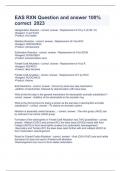
-
EAS RXN Question and answer 100% correct 2023
- Exam (elaborations) • 4 pages • 2023
- Available in package deal
-
- $12.49
- + learn more
EAS RXN Question and answer 100% correct 2023Halogenation Reaction -Replacement of H by X (X=Br, Cl) -Reagent: X and FeX3 -Product: Aryl halide Nitration Reaction -Replacement of H by NO2 -Reagent: HNO3/H2SO4 -Product: nitrobenzene Sulfonation Reaction -Replacement of H by SO3H -Reagent: SO3/H2SO4 -Product: benzensulfonic acid Friedel-Craft Alkylation -Replacement of H by R -Reagent: RCl/AlCl3 -Product: alkyl benzene Friedel-Craft Acylation -Replacement ...
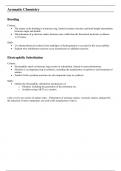
-
AQA A Level Chemistry - Unit 3.3.10: Aromatic Chemistry - Full Notes
- Summary • 6 pages • 2023
-
- $5.51
- + learn more
Detailed and comprehensive notes on unit 3.3.10 (aromatic chemistry) for AQA A level chemistry. Covers: benzene structure and stability, friedel crafts acylation, nitration of benzene, formation of aromatic amines, aromatic nomenclature and aromatic synthesis. Includes mechanisms with reactions conditions and drawings. I hope that you find this resource useful.
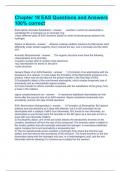
-
Chapter 18 EAS Questions and Answers 100% correct
- Exam (elaborations) • 9 pages • 2023
- Available in package deal
-
- $12.99
- + learn more
Chapter 18 EAS Questions and Answers 100% correct Electrophilic Aromatic Substitution -reaction in which an electrophile is substituted for a hydrogen on an aromatic ring -many different types of EAS reactions based on what functional group replaces the hydrogen Alkene vs Benzene Alkenes undergo addition reactions but Benzenes react differently under similar reagents. Don't confuse the two, one is Aromatic and the other isn't. Aromatic Requirements The organic structure must...
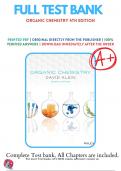
-
Test Bank for Organic Chemistry 4th Edition by David R. Klein | 9781119659594 |2021-2022 |Chapter 1-27 | All Chapters with Answers and Rationals
- Exam (elaborations) • 2151 pages • 2023
-
- $42.98
- + learn more
Test Bank for Organic Chemistry 4e 4th Edition by David R. Klein. ISBN-13: 9594 Full chapters test bank PDF TABLE OF CONTENTS 1 A Review of General Chemistry: Electrons, Bonds, and Molecular Properties 1 1.1 Introduction to Organic Chemistry 2 1.2 The Structural Theory of Matter 3 1.3 Electrons, Bonds, and Lewis Structures 4 1.4 Identifying Formal Charges 7 1.5 Induction and Polar Covalent Bonds 8 1.6 Reading Bond-Line Structures 11 1.7 Atomic Orbitals 14 1.8 Valence Bond Theory 17 1.9 Molecular...
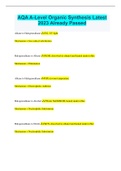
-
AQA A-Level Organic Synthesis Latest 2023 Already Passed
- Exam (elaborations) • 6 pages • 2023
- Available in package deal
-
- $9.99
- + learn more
AQA A-Level Organic Synthesis Latest 2023 Already Passed Alkane to Halogenoalkane X2, UV light Mechanism = free radical substitution Halogenoalkane to Alkene KOH, dissolved in ethanol and heated under reflux Mechanism = Elimination Alkene to Halogenoalkane HX at room temperature Mechanism = Electropholic Addition Halogenoalkane to Alcohol Warm NaOH/KOH, heated under reflux Mechanism = Nucleophilic Substitution Halogenoalkane to Nitrile KCN, dissolved in ethanol and heated under reflux Mechan...
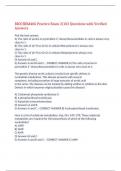
-
BIOCHEM406 Practice Exam 3|103 Questions with Verified Answers,100% CORRECT
- Exam (elaborations) • 32 pages • 2024
-
- $11.49
- + learn more
BIOCHEM406 Practice Exam 3|103 Questions with Verified Answers Pick the best answer. A) The ratio of purine to pyrimidine 2 ́-deoxyribonucleotides in cells is always very close to 1. B) The ratio of (A+T) to (G+C) in cellular RNA polymers is always very close to 1. C) The ratio of (A+T) to (G+C) in cellular DNApolymersis always very close to 1. D) Answers B and C. E) Answers A and B and C. - CORRECT ANSWER A) The ratio of purine to pyrimidine 2 ́-deoxyribonucleotides in cells is alwa...

-
MLT ASCP Chemistry Practice Questions And Answers 100% Correct!!
- Exam (elaborations) • 18 pages • 2023
- Available in package deal
-
- $11.99
- + learn more
MLT ASCP Chemistry Practice Questions And Answers 1 Which one of the following statements about acetaminophen metabolism is false? Choose the single best answer A. It is metabolized in the kidney B. It is largely metabolized in the liver to glucuronide and sulfonate conjugates C. A small amount is metabolized via cytochrome oxidase to a reactive benzoquinoneimine intermediate D. This intermediate becomes toxic to the liver once tissue glutathione becomes depleted - ANSWER-A; The benz...
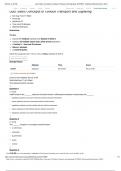
-
Exam (elaborations) NUTR641: Nutritional Biochemistry I (D01) (NUTR641) Quiz: Basic Concepts of Cellular Transport and Signaling {Answered}
- Exam (elaborations) • 9 pages • 2024
-
- $13.99
- + learn more
Quiz: Basic Concepts of Cellular Transport and Signaling: NUTR641: Nutritional Biochemistry I (D01) Quiz: Basic Concepts of Cellular Transport and Signaling Score for this attempt: 80 out of 80 Q uestion 1 2 / 2 pts regulatory subunits; two active monomers and two inactive monomers active subunits; two active monomers and an inactive dimer regulatory subunits; an active dimer and two inactive monomers active subunits; an active dimer and two inactive monomers regulatory subunits; t...
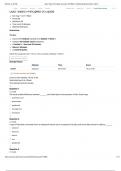
-
Exam (elaborations) NUTR641: Nutritional Biochemistry I (NUTR641) Quiz: Basic Principles of Lipids.
- Exam (elaborations) • 10 pages • 2024
-
- $16.04
- + learn more
Quiz: Basic Principles of Lipids: NUTR641: Nutritional Biochemistry I (D01) Quiz: Basic Principles of Lipids Score for this attempt: 78 out of 80 Q uestion 1 2 / 2 pts arachidonic acid plasmalogen ganglioside triacylglycerol cholesterol Q uestion 2 2 / 2 pts capsaicin terpenoid steroid wax ganglioside Q uestion 3 2 / 2 pts The quiz: Covers the Textbook material from Module 7: Week 7. Contains 40 multiple-choice questions. Is limited to 1 hour and 30 minutes. Allo...

-
A* GRADE AQA A-Level Chemistry: Organic - Aromatic Chemistry (3.3.10)
- Summary • 2 pages • 2023
- Available in package deal
-
- $4.13
- + learn more
I achieved a high A* Grade in my final A-Level exams using these notes!!! I believe you can achieve an A* if you can memorise these notes! Simply use blurting, a method of active recall, to write everything you remember from the notes, then identify the parts you couldn’t remember, then repeat until you can remember it all! If you can do that, you’ve got an A* in the bag! They are clear, concise, and are laid out according to the specification; there is no information missing or in excess...

Do you wonder why so many students wear nice clothes, have money to spare and enjoy tons of free time? Well, they sell on Stuvia! Imagine your study notes being downloaded a dozen times for $15 each. Every. Single. Day. Discover all about earning on Stuvia


